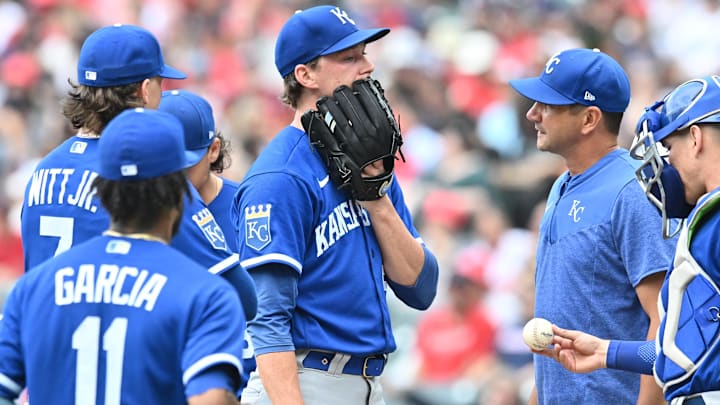Pitch location was an emphasis this offseason
Greg Maddux is considered one of the greatest pitchers of the modern era. He pitched 22 seasons with a career 1.143 WHIP. And yet, his career SO/9 was only 6.1. The point: Maddux was a great pitcher because he concerned himself with locating pitches and not beating down hitters. While Maddux could throw over 90, he rarely needed to. He finished his career with a 1.8 BB/9 and a 0.6 HR/9 despite giving up 8.5 hits per game.
The 2024 Royals starters look to have embraced Maddux’s philosophical approach. They are limiting home runs and walking far fewer batters. Meanwhile, the strikeout rate has not climbed. According to Fangraphs, the 2023 team finished the season 27th in strikeouts. The current squad ranks 26th.
And yet the improvements: from eighth to first in HR/9, from third to 30th in earned runs, and from 10th to 29th in BB/9 are all present. Why? Simply put, the Royals are locating their pitches and not trying to beat down hitters.
Look at Singer. He has increased his strikes per batter from 63.8 to 65.8% by reducing the number of balls he’s throwing (down 2% from last season). Because he’s locating his pitchers better, he’s inducing significantly more ground balls in 2024 (65.2%) than in 2023 (49.5%).
The KC Royals have expanded their collective repertoire
One issue previous versions of the Royals have suffered from was minimal pitch repertoires. Their youth movement of Singer, Kris Bubic, Daniel Lynch IV, and Jackson Kowar, always seemed to lack an adequate variety of pitches — especially Singer who until this season too frequently limited himself to just two pitches (more on that in a moment).
Newcomer Wacha does not have such issues. He comes with an expansive six-pitch arsenal, with varied velocity and movement. Marsh also boasts six pitches, and Ragans and Lugo both have five solid pitches. Picollo identified and chose starting pitchers who had more than two options, and Sweeney is urging the pitchers to take advantage of their options.
It's important to note that even Singer is in on this movement. For the first time, he's demonstrating he can, in fact, throw more than two pitches. While he still seems reluctant to utilize his changeup, Singer is throwing a four-seam fastball with far more regularity. Adding that third pitch makes his slider and sinker more effective; hopefully, we will see Singer develop something slower, too. Maybe he'll take a cue from some of his new teammates. Could a curveball be on the horizon?
